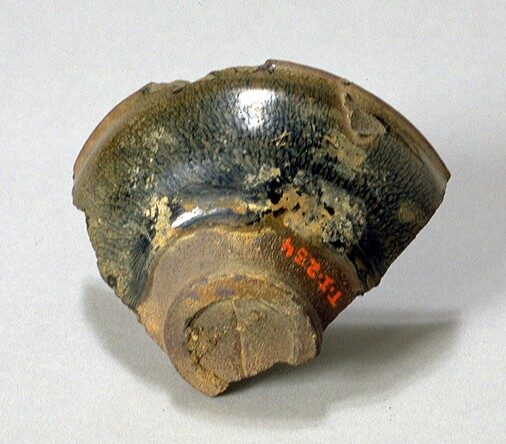Fragment of Jian Ware Bowl
Chinese

Description
Subject Matter:
Jian ware, Wade-Gils romanization Chien ware, Japanese name temmoku ware, Temmoku also spelled Tenmoku, dark brown or blackish Chinese stoneware made for domestic use chiefly during the Song dynasty (960–1279) and into the early 14th century. Jian ware was made in Fujian province, first in kilns at Jian’an and later at Jianyang.
The clay used for Jian ware was of a very hard, coarse grain. The inside and about two-thirds of the outside of the ware were covered with a thick, very dark glaze (coloured with iron oxide). This glaze usually stopped short of the outer base in a thick welt; it also tended to pool thickly on the inside of the vessel. Within a limited palette dominated by a purplish or bluish black or reddish brown, Jian ware had a range of variations. The most prized glazes resembled the streaking of a hare’s fur, the mottling of partridge markings, or the silvery splattering of oil spots.
Teabowls are by far the most common, though not the only, form of Jian ware that survives. Used by Chan (Zen) Buddhist monks in the Fujian region, the highly esteemed teabowls were carried back to Japan by Japanese monks who had visited China to study Chan Buddhism. Until the late 16th century, Jian ware, or temmoku ware, was the type of tea bowl preferred for the highly ritualized Japanese tea ceremony.
https://www.britannica.com/art/Jian-ware-Chinese-stoneware
Physical Description:
A fragment of a Jian Ware bowl with mottled black-brown glaze. It is on a short footing and a everted rim.
Usage Rights:
If you are interested in using an image for a publication, please visit https://umma.umich.edu/request-image/ for more information and to fill out the online Image Rights and Reproductions Request Form.